News & Blogs
Let’s dive into a profound cultural background of New Year's unique dishes, originally started as offerings to the deity.
Osechi-ryori (おせち料理) is an assortment of traditional Japanese New Year’s dishes.
All dishes are meaningful and full of wishes.
Modern day’s situation for Osechi-ryori
In this blog, we touch on diverse topics about Japanese food cultures, practices together with the culinary secret, TREHA®, and its important role in the Japanese food industry. We hope our blog helps you obtain in-depth knowledge of the secrets and science behind Japanese cuisine, shared from our kitchen, to yours.
What is Osechi-ryori (おせち料理)?
New Year's Day (Oshogatsu お正月) is Japan’s most crucial seasonal event. The event is to welcome the deity of the year (歳神様 Toshigami-sama), a god of harvest, who is believed to visit each house on the first day of a year to bestow happiness and health. While hosting the spiritual guest, the Japanese wish for a good harvest and family safety through New Year's events.
Various customs are practiced during the New Year’s celebration, each of which has cultural and traditional significance. Osechi-ryori (New Year’s Food) is an assortment of dishes shared with the whole family and any guests during the first three days of the New Year, which used to be the offering to the deity of the year (Toshigami-sama, 歳神様) placed on a tray called "Osechi.” The custom has been around since the Nara period (8th century).
Modern-time New Year dishes are prepared to wish for a good harvest, family safety, health, and prosperity. Each food item has significance and a specific space in lacquered wooden boxes called jubako (重箱). The jubako boxes packed with these dishes of happiness are stacked from two to five tiers topped with a lid for the celebration. Even though several theories exist, these towering boxes emerged from the late Edo period to the Meiji period (19th century) mainly because the stacked boxes symbolize "building up fortune" and vertical storage boxes are compact, making them easy to serve guests besides a few more convincible reasons.
Most dishes in osechi-ryori are prepared in advance and meant to be shelf-stable because people offered some break to a god of fire by reducing the use of stoves during the first three days of the New Year. In addition, it was believed that fire, a sacred presence, should be used by a deity alone. The custom to celebrate the first three days of the New Year with the shelf-stable dishes is rooted in such lore.
The number of jubako boxes for the dishes varies by region and family, but the official number of boxes is four or five. Nevertheless, many osechi-ryori are prepared in two or three-tiered boxes nowadays, as nuclear families are predominant without a need for more than three boxes.
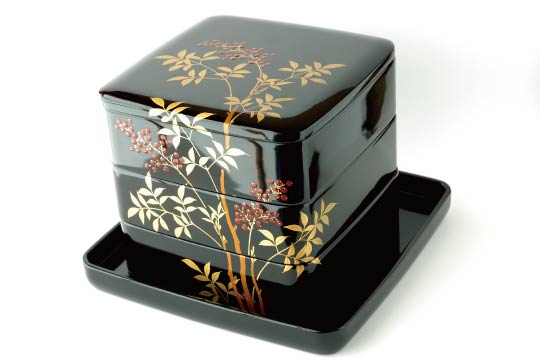
Traditional dishes with specific wishes.
Osechi-ryori is similar to a course menu roughly divided into the five categories below:
Iwai-zakana (祝い肴): Festive appetizers paired with alcoholic beverages (mainly sake)
Kuchitori (口取り): The first dish consisted of hors d'oeuvres.
Yakimono (焼き物): Grilled/cooked seafood with auspicious names.
Sunomono (酢の物): Dishes marinated in vinegar.
Nimono (煮物): Stewed vegetables.
Each item has a specific “address” to be placed, such as location in a box and the tire of the stacked boxes.
For an example of three-tiered jubako boxes,
Iwai-zakana (祝い肴 appetizers) and Kuchitori (口取り the first dish) are placed in the top box (ichi-no-ju 一の重).
Yakimono (焼き物 grilled seafood) and Sunomono (酢の物 Dish marinated with vinegar) are placed in the middle-box (ni-no-ju 二の重).
Nimono (煮物 stewed vegetables) are placed in the bottom box (san-no-ju 三の重).
Though the number of items varies by region, the boxes are filled with 20 to 30 different dishes in general. Traditional Japanese chefs approve TREHA®, which brings the quality up a notch by enhancing flavors and maintaining freshness. Here are typical osechi ryori dishes, their significances, and the benefits of TREHA®:
The top box (一の重 ichi-no-ju)
The top box includes Iwai-zakana (appetizers) and Kuchitori (the first dish). In the Greater Tokyo Area (Kanto region), the appetizer consists of "kuromame (黒豆 black soybeans)," "tazukuri (田作り candied baby sardines)," and "kazunoko (数の子 marinated herring-roe)."
In the southern-central region (Kansai region), "tatakigobo (たたきごぼう pounded burdock roots with sesame sauce)" take the place of black soybeans.
Classic first dishes are "kamaboko (かまぼこ fish cake)," "kuri-kinton (栗きんとん Candied chestnuts and sweet potatoes),” "kobumaki (昆布巻 kelp rolls filled with cooked salmon)," and "datemaki (伊達巻 Sweet rolled omelet)."
Significance of “kuromame (黒豆 Black soybeans)”:
In Japanese, the word "mame,” meaning “beans,” has other meanings, such as living in good health or working diligently. In the Kanto region, black beans are cooked until their surfaces get wrinkly, wishing for long healthy life. On the contrary, in the Kansai region, plump and glossy black soybeans are preferred because the absence of wrinkles is considered a symbol of everlasting youth and immortality.
TREHA® retains moisture in soybeans, making them plump. TREHA® also extends shelf life because its low sweetness allows increased sugar content.
Significance of “Tazukuri (田作り Candied baby sardines)”:
Tazukuri is roasted baby sardines coated with sugar, soy sauce, and mirin (sweet sake). Since sardines are used as fertilizer, they symbolize a good harvest. In addition, baby sardines are considered the auspices of the flourishment of descendants.
TREHA® reduces the bitterness of small fish and enhances the gloss due to its stability in candied conditions.
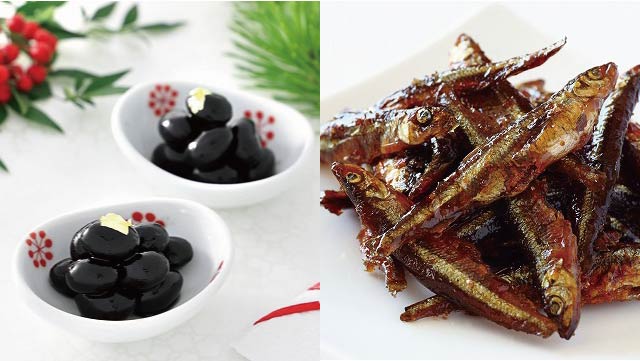
Significance of "Kazunoko (数の子 herring-roe)”:
Herring-roe, marinated in the seasoning sauce, symbolizes fertility and family prosperity as herring lays so many eggs.
TREHA® can reduce fishy odor when used in the marinade.
Significance of “Tataki gobo (たたきごぼう/ Pounded burdock roots)”:
Burdock root is a beloved vegetable in the Kansai region, which symbolizes longevity and prosperity because of their long and vital root. Pounded burdock roots seasoned with sesame sauce often become part of New Year’s feast, wishing for a family to grow strong and peacefully within its community.
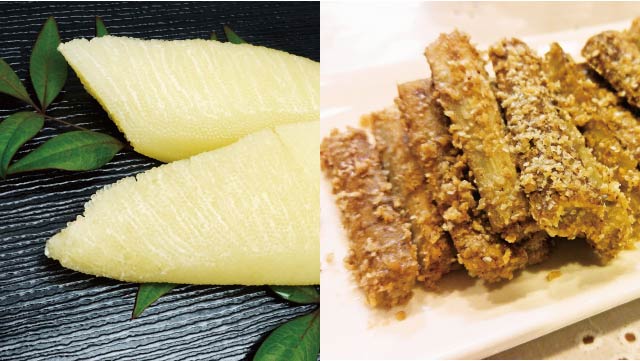
Significance of “Kamaboko (かまぼこ fish cake)”:
Kamaboko is a steamed fish sausage mounted on a piece of wood, which comes in pink or white colors as “kohaku (red-and-white)” is believed to be a promising color combination.
Significance of “Kuri-kinton (栗きんとん sweet potato mashed with candied chestnuts)”:
Due to its golden color, kurikinton is auspicious food bringing in fortune. Kanji characters describe “kinton” as a mass of gold (金団), whereas “kuri” means chestnuts.
TREHA® allows increased sugar content to make the product shelf-stable without making it too sweet while enhancing the appearance by adding gloss.
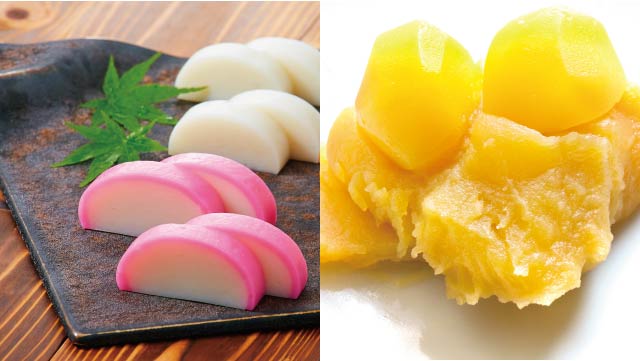
Significance of “Kobumaki (昆布巻 Kelp rolls stuffed with fish)”:
The traditional stuffing is "herring" (nishin ニシン) based on an auspicious homophone. The pronunciation of "herring" (nishin ニシン) is identical with “parents” (nishin 二親) whereas the pronunciation of “kelp” (also known as “kombu”) is similar to “happiness (喜ぶ)” or “childbearing "(子生).” Stuffed kelp rolls, consisting of ingredients with lucky pronunciations, symbolize parents who have long and happy lives filled with many children. When used in hot water to pretreat herring, TREHA® reduces its fishy smell.
Significance of “Datemaki (伊達巻 Sweet rolled egg pancakes)”:
The food can be described as a sweet rolled pancake of white fish paste and eggs. The shape resembling old books (scrolls) symbolizes a wish to accumulate knowledge.
Replacing 20-30% TREHA® in place of sugar can reduce extra sweetness while maintaining a moist texture. Click here to watch how TREHA® slows down the coagulation of eggs.
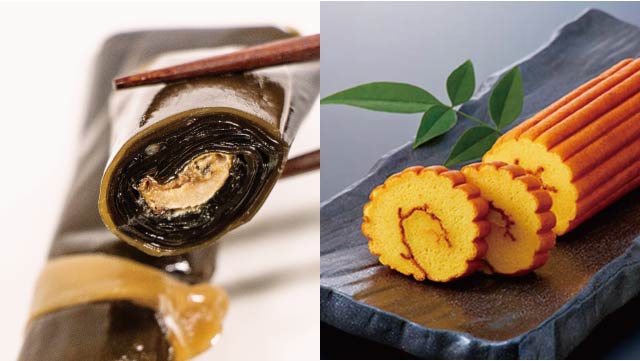
The middle-box (二の重 ni-no-ju)
The middle-box contains yakimono (grilled seafood) and sunomono (dishes marinated in vinegar).
Significance of "Tai-no-sugatayaki (鯛の姿焼き Grilled sea bream)”:
The word "tai (鯛 sea bream) is similar in pronunciation to the word "medetai,” meaning happiness (めでたい)." In addition, a sea bream always appears with a god of fishing and commerce, “Ebisu,” making it suitable for celebrative occasions.
Significance of "buri-no-teriyaki (ぶりの照り焼き Yellowtail teriyaki)”:
Yellowtails are called by different names based on the growth size in Japan, just like a human landing on better positions as their career advances. Therefore, yellowtail is nicknamed a fish frequently promoted” (Shusseuo 出世魚).
TREHA® suppresses the fishy smell while retaining a soft and moist texture when used in pretreatment. In the teriyaki sauce, TREHA® increases sugar content and thickness without adding extra sweetness. The teriyaki sauce containing TREHA® is less prone to burning during grilling and coats the fish surface instead of being soaked in for a better presentation.
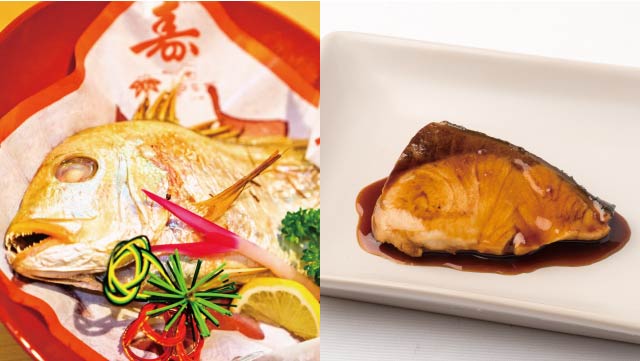
Significance of prawns:
When boiled, a prawn bends like an aged person, which signifies longevity.
TREHA® enhances vibrant colors and suppresses the unpleasant odors of fish and shellfish. Prawns boiled in water containing TREHA® become more vividly colored with less noticeable head-darkening and unpleasant odor.
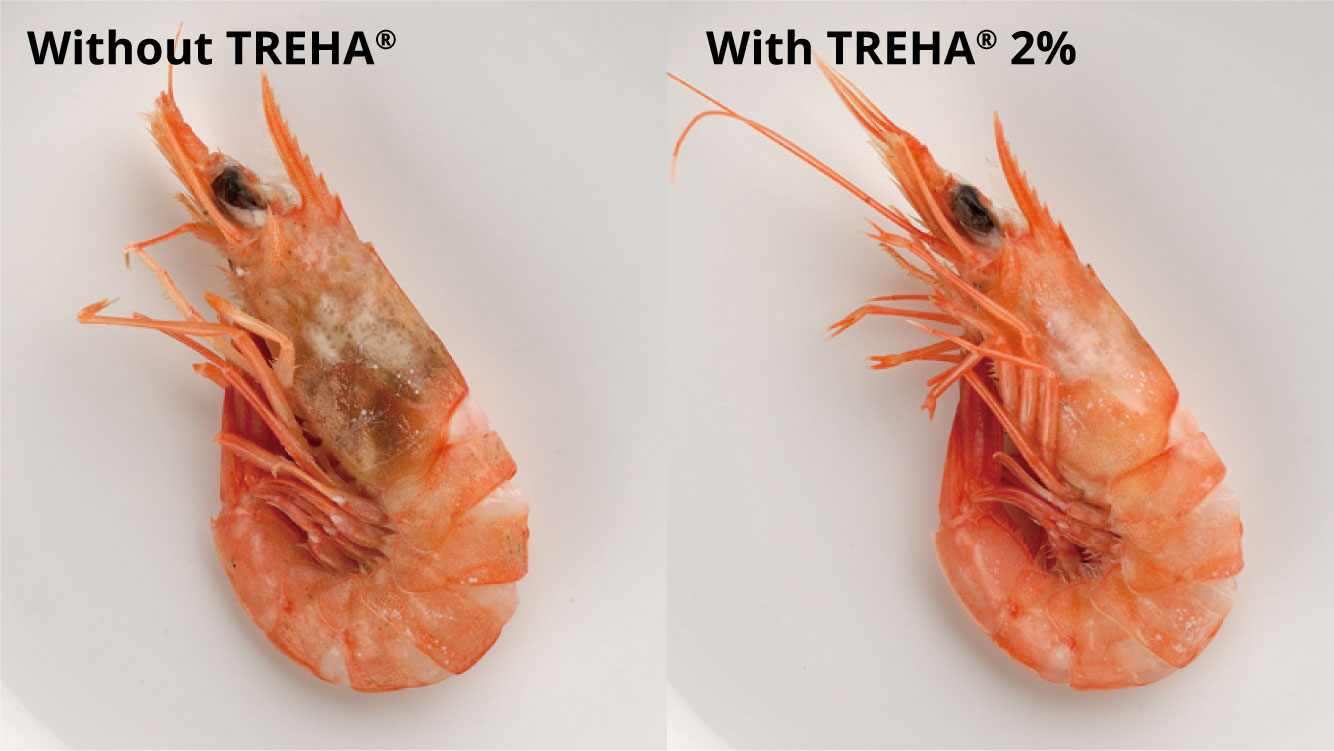
Significance of “Kohaku namasu (紅白なます Pickled daikon radish and carrot strips)”:
The color combination of red and white indicates a festive occasion. Since it resembles a mizuhiki code, the dish symbolizes a peaceful relationship within the family and community.
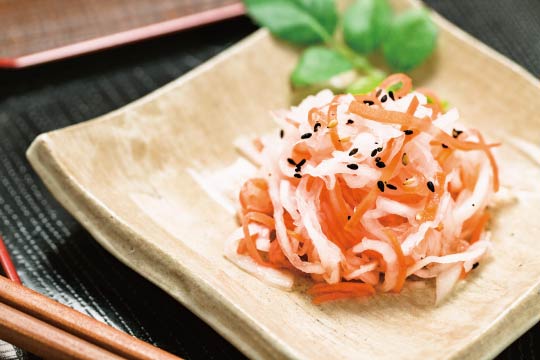
The bottom box (三の重 San-no-ju)
Unlike other boxes with multiple colorful dishes, the bottom box is dedicated to stewed vegetables alone. The stewed vegetables are called "onishime お煮しめ.” The name is based on a homophone word play linked with "oni shime 鬼締め,” meaning slaying demons. A wish behind the dish is health and a strong family tie, free from bad luck caused by demons. Root vegetables play essential roles in this strew.
Lotus root, "Renkon (蓮根),” features many holes, making the future prospects clear and straightforward. Taro root (satoimo 里芋) produces many small potatoes, symbolizing the flourishing family.
TREHA® makes root vegetables soft and moist and suppresses acridity, specific to root vegetables.
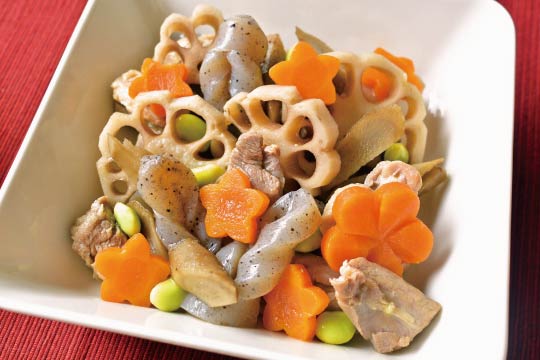
New Year’s Dishes (Osechi ryori) in modern Japan.
The Japanese prepare various New Year’s dishes (osechi-ryori) in jubako boxes, wishing health, longevity, and prosperity. Traditional dishes are time-consuming to make from scratch. More and more people are ordering the New Year’s dishes prepared by their favorite restaurants. Alternatively, home chefs fill the jubako boxes with premade items from supermarkets or depachika. Those places are incredibly crowded with many people, including myself, year-end. I have never handmade the dishes.
Chef Shimomura, the owner-chef of MOTOMACHI SHIMOMURA, also takes the pre-orders of the New Year’s dishes containing TREHA®. Click here for his interview, commenting on the festive dishes.
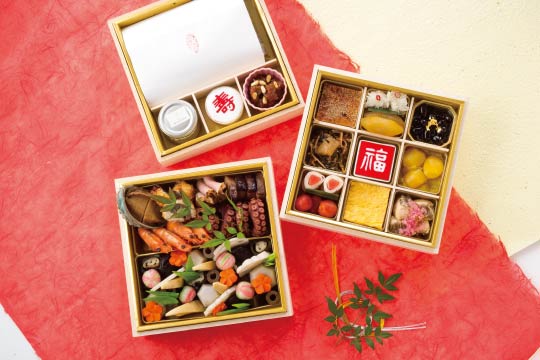
Nowadays, western dishes such as roast beef and Chinese dishes are packed in jubako boxes as part of New Year’s dishes, reflecting the diversification of food and freshness preservation technologies, including quick-freezing and efficient logistics. Although the food items have changed, the original concept, offerings to the deity on New Year’s Day, has not changed.
What kind of food would you like to make for the New Year? We hope you continuously enjoy reading our blog this year.
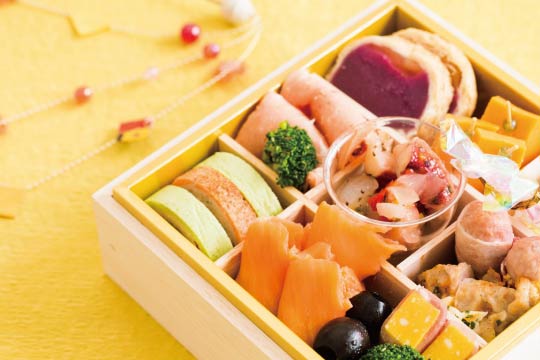
Did you find this blog interesting?
Please share it with your friends in the food service industry.
We regularly update the blog about the food culture of Japan, where TREHA® was discovered for culinary applications.
Click here and send us a message to subscribe.
Or hit us up on Instagram @trehalose_sensei!
You might also be interested in:
Japanese traditional food series 2: Chitose Ame, candy for healthy longevity (千歳飴)
Japanese traditional food series 3: Yuzu (柚子) and the winter solstice
Japanese traditional food series 4: Noodles on New Year's Eve (年越しそば)
Japanese traditional food series 6: Another traditional food for New Year’s celebration, mochi (餅)
Japanese traditional food series 13: Inari sushi offered to a deity of harvests

